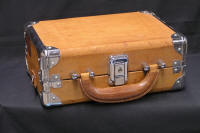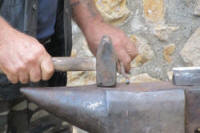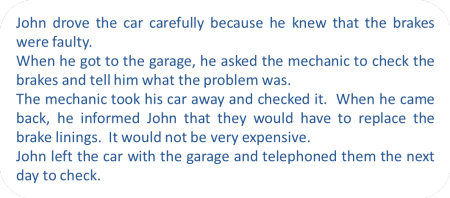Unit 5: subjects, objects and adverbials

This Unit draws on the knowledge of verbs that you acquired in Unit
3.
If you cannot remember the difference between transitive,
intransitive, ditransitive, monotransitive and ambivalent verbs,
here's some revision.
Look at the verbs in the left-hand column, make a sentence or two in
your head and then click on the
![]() to get some comments:
to get some comments:
|
smoke |
This verb can be
transitive or intransitive so it is ambivalent. We
can have, e.g.:
She smoked a cigar (transitive) and She smokes (intransitive) |
|
give |
This verb is
always transitive because we cannot say simply:
*She gave because it must have at least one object as in: She gave her time willingly but it is also frequently ditransitive as in, e.g.: She gave me the money or She gave the money to me in which the money is the direct object and me is the indirect object. |
|
come |
This verb is intransitive. We cannot say:
She came the party but we can say She came to the party |
|
destroy |
This verb is monotransitive only. We can say:
He destroyed the old shed but we cannot say: *He destroyed or *He destroyed me the shed |
Hopefully, by now, you found that quite easy.
If you couldn't do that, you should review the section in
Unit 3.
There are 4 sections to this unit and here's the menu.
Clicking on the yellow arrow at the end of each section will return you
to this menu.
| Section | Looking at: |
| A | Subjects and objects Identifying which is which. |
| B | Passive and active voice clauses Raising the object to the subject position. |
| C | Multi-word
verbs Transitive and intransitive |
| D | Adverbials Modifying and completing verb phrases. |
Section A: Subject and Objects
 |
A task |
The subject of a verb is who or what does the action or exists in
the state.
The object is the thing or person on which the verb acts or which
receives or benefits from the action.
So, in, for example:
- John broke the glass
John is the subject (who did the action) and the glass is the object (which received the action) - The weather improved
The weather is the subject and there is no object - Fred went to Margate
Fred is the subject and, again, there is no object (the verb is intransitive) - That man in the corner with the old dog bought everyone
a drink
We have a more complicated sentence but we can still say:- That man in the corner with the old dog is the subject
- a drink is the first, direct object (because that is what he bought)
- everyone is the second, indirect object (because they were the people who got the benefit)
In this list, can you identify the subject and the objects? Click on
![]() to show the answer
to show the answer
| 1 | She was carrying her books |
| 2 | Some of Mozart's earliest compositions are on the radio tonight |
| 3 | That he was allowed to leave early surprised me |
| 4 | I told her that the money was not enough |
| 5 | The University press published the book for him |
| 6 | In the corner is the best place for it |
| 1 | She was carrying her books | This is an easy one: she is the subject her books (not just books) is the object. The verb carry is always transitive so must have an object. |
| 2 | Some of Mozart's earliest compositions are on the radio tonight | This sentence has a long subject
noun phrase but no object. The subject is: Some of Mozart's earliest compositions but there is no object because the verb (be) is a copular verb and they take complements, not objects. |
| 3 | That he was allowed to leave early surprised me | This sentence is unusual. The subject is not a noun or a pronoun, it is what is called a nominalised clause. The clause: That he was allowed to leave early has been made into a noun (that is what nominalised means). The object is me. |
| 4 | I told her that the money was not enough | This is another unusual sentence
because the subject is clear (I) but the object is: that the money was not enough which is another nominalised clause acting as the object of the verb. We also have an indirect object (her) and the verb is also unusual because in this meaning (inform) it must take an indirect object. |
| 5 | The University press published the book for him | This is not easy. The subject is clear. It is: The University press and the direct object is, of course, the book. You would be forgiven for thinking that we also have an indirect object (him) but we cannot say: The University press published him the book so the phrase for him is actually an adverbial, not a real object. |
| 6 | In the corner is the best place for it | This contains an uncommon subject
phrase which is a prepositional phrase that has been
nominalised to act as a subject of the verb (in the
corner). There is no object because, again, the verb is copular. |
So, the moral is that subjects and object are usually simple (and
not so simple) noun phrases but sometimes we can convert clauses and
phrases into nouns and then use them as the subject or object of
verbs.
That is what has happened in sentences 3., 4. and 6.
 |
Case |
So we have the terminology right, what we are talking about here with terms such as subject and object is to do with case:
- the subject is the nominative case
- the object is the accusative case
- possession is signalled by the genitive case
Other languages are much more enthusiastic about case, making
changes to articles, adjectives, nouns and all sorts of other elements to
conform to the case in which they appear.
English is simpler (although the pronoun system is heavily
influenced by case considerations) and we can happily just talk
about the subject, object and possessive cases, however
non-technical and loose it sounds.
In fact, there are those who aver that English doesn't really have
a case grammar (or not much of one).
 |
Ordering the elements |
A very simple way to identify the subject and object of verbs in
English, which may be how you solved the puzzles above, is to look
at where they come in the sentence.
This is because English does not mark the subject and the object in
any way (by, for example, changing an ending or altering the form of
the determiner).
This means, therefore, that the difference between:
The traffic jam caused the delay
and
The delay caused the traffic jam
can only be understood by looking at the order of the elements.
In English, the most common way, by far, is to put the Subject
first, then the Verb and then the Object (if any).
English, therefore, is described as an SVO language.
Other languages do thing differently.
In English, we know that the difference between:
The man told the woman
and
The woman told the man
is determined by which element goes where in the sentence. In
the first, we know that the man did the telling and in the second
that it was the woman.
In other languages, German, for example, which has a sophisticated
case grammar, the first sentence is:
Der Mann sagte der Frau
and the second sentence is
Die Frau sagte dem Mann
and you can see that the form of the word for the is
different (der, die and dem).
Those two sentences translate like this:
| German | Der | Mann | sagte | der | Frau |
| English | The | man | told | the | woman |
| German | Die | Frau | sagte | dem | Mann |
| English | The | woman | told | the | man |
And you can see in the yellow boxes how the article (the) changes depending on who did the telling and who was told. When the man is the subject, the article is der and when the woman is the subject, the article is die. However, when the man is the object, the article is dem and when the woman is the object, the article is der.
This means that:
Dem Mann sagte die Frau
still means
The woman told the man
even though the phrases have been reversed.
We can reverse the phrases in English, of course, but if we do, we
change the meaning of the sentence.
In the essential guide to subjects and object on this site,
linked below, you can access a list of languages some of which are
SVO (like English) and some of which have a different ordering,
often SOV (like
Bengali,
Farsi,
Hindi,
Hungarian, Japanese,
Korean and
Turkish), where the usual ordering is different so in those
languages the sentence would be:
The woman the man told.
 |
Learn moreIf you want to discover more now about subjects and
objects, go to: |
 |
Take a test |
To make sure you have understood so far, here's a little test.
Identify the subjects and the objects of the verbs in this story and
then click on the story for the answers.
|
|
Notice that:
|
Section B: Passive and Active voice
 |
My camera's been stolen! |
Now that we know the difference between the subject and the object, we can make things confusing!
As we saw above, most English positive sentences follow the SVO ordering so we get, for example, all the sentences in the left-hand column of this table:
| Active | → | Passive |
| He spent the money | The money was spent (by him) | |
| Mary did the work | The word was done (by Mary) | |
| The car has damaged the fence | The fence has been damaged (by the car) | |
| My team did the best work | The best work was done by my team, not the other teams |
but now we need to consider what is happening in the right-hand
column.
The sentences in the yellow column are all active sentences and that
is the usual way positive sentences are formed as we have seen.
In the green column, we have the passive sentence equivalents and we
choose this form because:
- We don't know what the subject of the active sentence is as
in:
My camera has been stolen - We don't care who the subject is as in:
The house has been sold - The subject is obvious to everyone as in:
She has been arrested - We want to make the subject even more important as in:
The window was broken by the neighbours' children, not our children
Overall, the simpler way of saying all this is that we use a passive sentence or clause when we want to mark something in the sentence as being particularly important. In these sentences that is:
- my camera
- the house
- she
- the neighbours' children
In the first three sentences, it is not necessary to insert the phrase with by so that is optional and why it was in brackets in the green column.
 |
Forming a passive sentence |
This is how we make a passive voice clause in English (languages differ):
- Find the object and put it first
- Insert the correct form of the verb be
- Insert the correct form of the main verb (the past participle)
- (Insert by + the original subject of the sentence)
If you want to see how that's done with a different example, watch this little video:
We can only form a passive sentence when there is an object
(otherwise there is nothing to raise to the patient position in the
sentence) but we can form two passive clauses from a ditransitive
verb so from, e.g.:
The head teacher gave all the children a
prize
we can form both:
A prize was given to all the children
and
All the children were given a prize.
Even when there is an object, some verbs will not form passive
sentences so there are no passive equivalents of, e.g.:
The car lacks petrol
They possess enough money
She suffered a panic attack
She has no time
 |
Describing a passive sentence |
There is a temptation to keep with the terms subject and object
when describing passive clauses but that leads to a certain amount
of confusion and looseness. We cannot really describe the
book in:
The book was written by my sister
as the subject because we then have no way to describe my sister.
For this reason, we refer to the object of the active sentence as
the patient and the subject as the agent, like this:
| Patient phrase | Verb phrase | Agent phrase |
| The money | was lost | by the children |
| The car | will be repaired | by the workshop |
| Anyone who comes late | may be refused entry | by the manager |
Please remember:
A passive sentence does not mean exactly the same as the active
sentence. If that were the case, there would be no need for it
at all.
We select the passive because we want to emphasise something the
sentence, not just at random.
 |
Learn moreIf you want to discover more now about passive clauses, go to: There is also a short lesson for learners on understanding the passive. |
 |
Take a test |
To make sure you have understood so far, try
a test of your knowledge of
the passive.
Use the 'Back' button to return when you have done that.
Section C: Multi-word verbs
 |
A confusing area |
The guide to multi-word verbs on this site is the longest of all
because this is a deeply confusing and confused area.
Most websites which try to analyse the area for learners (and, alas
teachers) get it wrong so here we will try to be simple.
A multi-word verb consists of more than one word. It is, if you
like, a self-contained verb phrase.
This means that in a sentence like:
She gets on well with her father
we do not have the verb get operating alone. What we have
is the verb get on which has a different meaning from the verb
get. The object of that verb is her father but
in this example:
I got the money from my father
the object of the verb is the money and from my father
just tells us where it came from. In this sentence, the verb
phrase is just the word get and it is
NOT
get from.
The following are all examples, in red, of multi-word verbs:
- They looked up the word in the dictionary
- I abstained from voting
- I came across some old photographs
- She caught up with the rest of the runners
- I give in
- She complained about the service
Here, we have examples of three types of multi-word verbs:
- Sentences 1, 3 and 5 contain phrasal verbs.
Phrasal verbs are formed from a verb and an adverb and both parts contribute to the new meaning of the verb.
For example, we can have:
She looked at the newspaper
She looked under the car
We looked over the fence
and many more ways of looking but the meaning of the verb look is unchanged in all these cases so these are not phrasal or multi-word verbs.
However, if we say:
She looked after the children
She looked out for her mother
we are changing the meaning of look by combining it with the adverb particle (after and out). - Sentences 2 and 6 contain prepositional verbs. These
are often (and some say more correctly) called verbs with
dependent prepositions.
The meanings of the verbs are unchanged by the prepositions but we are very limited (sometimes to only one) in the choice of prepositions to follow the verb.
We do not always need the preposition with these verbs so we can also say:
I abstained
and
She complained
but sometimes the preposition is required so we cannot say, for example:
*I longed
or
*I deal
without saying what for and what with. - Sentence 4 contains a combination. We have the phrasal verb catch up with a dependent preposition, with so the combination is called a phrasal-prepositional verb.
Phrasal verbs in particular give learners significant problems because:
- They do not exist in many languages and even when there is something similar, it often works differently.
- Word ordering is a problem because we can have, for example:
She looked the word up
She looked up the word
and
She looked it up
we cannot allow:
*She looked up it
because that would be a verb (look) with a prepositional phrase telling us in what direction she looked. It might be rephrased as:
She looked up the tree and saw the squirrel
and in that, of course, the verb does not mean consult a dictionary. - Most real phrasal verbs work this way but there are a number which cannot be separated like this and there is no simple rule to apply.
- Too many teachers don't know how to analyse phrasal and other forms of multi-word verbs or even how to recognise them.
For much more detail, see the links below.
The problem comes when people are unable to do the analysis carefully enough so we find the following examples described as phrasal verbs:
- He got on the bus
This is just the verb get meaning move to another place with a prepositional phrase on the bus. We can have also:
He got over the wall
He got in the car
He got out of the room
and lots more but the meaning of get is unchanged.
It is not an example of a multi-word verb. - He turned down the road
This is another verb with a prepositional phrase, down the road and it is not a phrasal or prepositional verb because many more possibilities can be inserted such as at the traffic light, into the lane and so on.
It can be a phrasal verb when we have:
He turned down the work
because that means reject and is a case of the verb combining with the adverb to make a new meaning. In this case the verb is turn down not just turn and it is a phrasal verb. - She called back
This is not a phrasal verb although back is an adverb. It is just the verb modified by the adverb without any change of meaning.
We can also have:
She called again
She called frequently
She called repeatedly
and so on.
The moral of the story is not to trust what you read on the web,
especially concerning phrasal, prepositional and phrasal-prepositional
verbs.
The links below will take you to some reliable guides.
 |
Learn moreThis link takes you to the in-service guide to the area: |
 |
Take a test |
To make sure you have understood so far, try
a test to see if you can recognise the three sorts of multi-word
verbs and recognise verbs which are just verbs followed by a
prepositional phrase or an adverb.
Use the 'Back' button to return when you have done that.
Section D: Adverbials
 |
Distinctions first |
Unit 3 explained how to recognise and use adverbs and adverbs are
a kind of adverbial.
Unit 4 explained how prepositions combine with noun phrases to make
prepositional phrases and prepositional phrases are also often
adverbials.
That said, all adverbials are not adverbs.
Confused? Examples will help.
Adverbials are any words or phrases which tell us more about the verb.
For example:
John walked
is a perfectly comprehensible sentence standing alone. However,
John walked quickly to work this morning in the rain because his wife
had the car
tells us much more about the verb walk including:
where John walked (to work, in the rain)
how he walked (quickly)
when he walked (this morning)
why he walked (because his wife had the car).
All the words and phrases in brackets above are adverbials of some kind.
They come in this order:
- spatial
to work
telling us where or in what direction.
in the rain
telling us the surrounding circumstance.
Both of these, you now know, are prepositional phrase adverbials. - manner
quickly
telling us how.
You have probably recognised this as an adverb. - temporal
this morning
telling us when.
This is a noun phrase with a determiner, as you know. - causal
because his wife had the car
telling us the reason.
This is a complete clause linked with a conjunction telling us the reason for something.
Here are some more examples of concepts expressed using adverbials which are not adverbs:
- She contradicts me from time to time
- Mary went into the room without rushing
- They enjoyed the party a lot
- He looked to the sky
- He is coming in a moment
- They arrived after time
We can, naturally, express all those ideas with simple adverbs, like this:
- She contradicts me sometimes
- Mary went into the room slowly
- They enjoyed the party greatly
- He looked upwards
- He is coming soon
- They arrived late
 |
3 cases of non-adverb adverbials |
Apart from adverbs, English has three main ways of modifying (i.e., adding information to) a verb.
 |
Prepositional phrases |
| Go over the bridge |
Prepositional phrases are the most common type of non-adverb
adverbial. They are, in fact, even more common as a way of adding
information to a verb than adverbs themselves.
They are formed by the preposition (over, under,
round, through, by, before, after, to, from etc.) and its complement (or
object) which is usually a noun phrase. Like this:
| Preposition | Noun-phrase complement / object | Example | Function |
| before | lunch | They went for a walk before lunch | a time adverbial adding information to went for a walk |
| to | my house | She came to my house | a place adverbial adding information to the verb came |
| round | the shopping centre | They walked round the shopping centre | a place adverbial adding information to walked |
| in | in French | She spoke to me in French | a manner adverbial adding information to the verb spoke |
Often, in almost all languages, sentences will contain a combination of
prepositional phrases which each supply different sorts of extra
information about the verb so we can have, for example:
He walked over the hill
to my house in the morning
which contains three prepositional phrases:
over the hill
(a prepositional phrase adverbial of place, specifically
direction)
to my house
(ditto)
in the morning
(a prepositional phrase of time)
It is important that you know that the prepositional phrases in, for
example:
She went to the house
on the corner
are not both adverbials because
to the house
tells us where she went and is an adverbial but
on the corner
does not tell us where she went, it tells us where the
house is so it is modifying the noun, not the verb.
Prepositional phrase adverbials normally tell us when
or where (i.e., they are time or place adverbials).
That is not always the case because they can tell us other things.
For example:
She muttered under her
breath
tell us how she spoke, not where or
when.
 |
Noun phrases |
| He lives next door |
Noun phrases as adverbials are not very common but there are times
when we do not need a preposition and the noun phrase can stand alone to
tell us more about the verb. Here are three examples:
He arrived yesterday
evening (a noun-phrase time adverbial)
He speaks a great deal
(a noun-phrase adverbial of extent)
They went home
(a noun-phrase adverbial of place)
Be careful here not to confuse noun phrases acting as the object of
the verb with noun phrases acting as adverbials or modifying another
noun. For example, in:
She bought the house next
door
the phrase next door is
not an adverbial, it is modifying the house, not the verb, and
the house is a noun phrase but not an adverbial because it is
the direct object of the verb.
 |
Clauses |
| Spending time where she likes |
A clause, by some definitions, is a group of words which contains at least one verb.
Clauses can act as adverbials in many ways: how, where, when
and why. For example:
They are doing it the
way I told them to
tells us how they are doing it
I am living where
I want to be
tells us where I am living
She went to the cinema
after she left work
tells us when she went
He asked because he
needed the money
tells us why he asked
 |
Learn moreIf you want to discover more now about adverbials, go to: |
 |
Take a test |
To make sure you have understood so far, try
a test of your knowledge of
adverbials.
Use the 'Back' button to return when you have done that.

